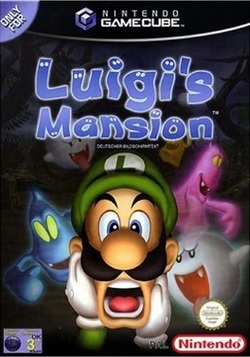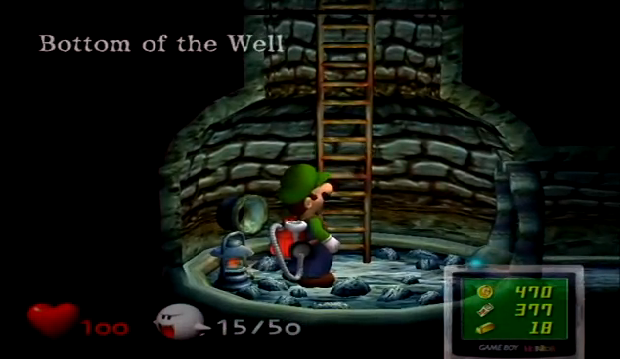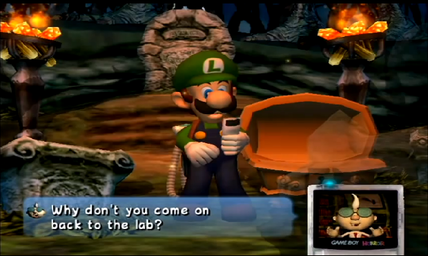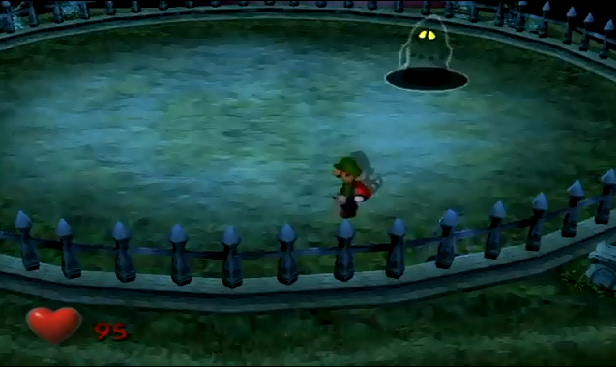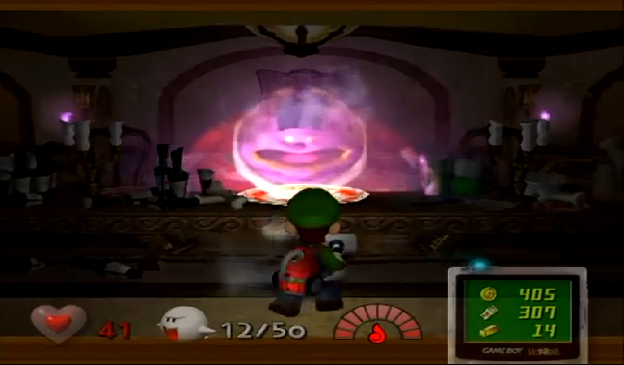LUIGI'S MANSION (GC)
Back when the GameCube launched around 2002, there was much hype surrounding the small squared console. As long-time Nintendo fans salivated at the prospect of a new Zelda, teases of a reinvented Metroid game and, perhaps most importantly, Mario’s debut on the console, the selection of launch titles fared somewhat poorly. One title was Luigi’s Mansion, which in turn felt the heat due to the fact Mario’s brother took the leading role. Branded “Where’s Mario?” by more cynical gamers, it still was a title worth keeping your eye on – especially as a sign of the GameCube’s potential. It certainly showed it: no more, no less.
Luigi has won a mansion! But instead of celebrating and inviting his friends to party, he realises he can't even remember entering the competition. So, with the assistance of Mario, he goes to investigate, but before anything can be done, Mario completely vanishes. And, just to make things tougher for poor old Luigi, the mansion is packed to the rafters with ghosts which he must capture in order to find his brother. Zoinks!
You have to commend Nintendo for taking a brave step with Luigi’s Mansion, which is far from your typical Mario game. The green plumber can’t even jump: instead, he is merely armed with a torch and Poltergust 3000, turning Luigi’s adventure into the videogame equivalent of Ghostbusters. The main meat comes from capturing Ghosts, which is a rather simple process. After shining the torch on a ghost’s heart, you must then suck them into the Poltergust, and a tug-of-war style event occurs where Luigi must keep a hold of the ghost while they try to squirm out. Whether you’re capturing ghosts or exploring, controlling Luigi is simple despite the GameCube’s convoluted controller. It’s just what you’d expect from a Nintendo-made game.
How much trouble you have capturing a ghost depends on what kind of ghoul you encounter. Smaller ghosts take seconds to capture, while tougher ones can take repeated attempts. 22 Gallery Ghosts are lurking around the mansion, and some of these are incredibly tough. Boss fights, on the other hand, mostly boil down to finding the weakness and repeatedly exploiting said weakness. Tough Elemental Ghosts also pose a threat, but give reward in return, as you are temporarily granted the power for use on puzzles. Some ghosts can cause frustration due to a lack of health items, as you sometimes go dozens of minutes without finding any health items, and it can leave you furious when you must fight a Gallery Ghost again after defeating it.
Luigi’s Mansion has solid gameplay foundations, but it suffers because it doesn’t grow as an experience. A pattern starts to emerge, as though rooms change superficially, you’re essentially repeating the same core structure. Ghosts need sucking up, an item drops to allow progression into another room, and repeat. There is some reprieve from item hunting, however, as collecting currency in the form of diamonds, coins and cash contribute to an end rank with better rewards. You’ll also need to keep an eye out for Mario’s items, as finding certain belongings – such as his glove – will help you track him down. The Mansion serves as a fun place to explore, with a good three floors to search as well as a basement and roof. Unfortunately, rooms themselves can suffer from a lack of space, as high density of furniture often cramp the surroundings.
Luigi’s Mansion did a great job of showcasing the GameCube at launch. Luigi himself looks terrific, particularly through the hilarious expressions he makes throughout the game. The environment reacts intricately to your actions, such as how the Poltergust sucks curtains, clothing and other objects in. The real-time lighting is also impressive, as shining Luigi’s torch on anything gives it a realistic shadow. Some textures are a bit naff, and the frame-rate can suffer at times, but overall, it’s super pretty. LM also benefits from some great music, which is actually quite atmospheric. Some moments are dead silent, meaning when the music begins to swell during ghost encounters, it becomes quite tense. The comedic dialogue lightens the game a bit, and the Ghost cries remind you that you’re playing a Nintendo game in a good way.
Luigi’s Mansion has solid gameplay foundations, but it suffers because it doesn’t grow as an experience. A pattern starts to emerge, as though rooms change superficially, you’re essentially repeating the same core structure. Ghosts need sucking up, an item drops to allow progression into another room, and repeat. There is some reprieve from item hunting, however, as collecting currency in the form of diamonds, coins and cash contribute to an end rank with better rewards. You’ll also need to keep an eye out for Mario’s items, as finding certain belongings – such as his glove – will help you track him down. The Mansion serves as a fun place to explore, with a good three floors to search as well as a basement and roof. Unfortunately, rooms themselves can suffer from a lack of space, as high density of furniture often cramp the surroundings.
Luigi’s Mansion did a great job of showcasing the GameCube at launch. Luigi himself looks terrific, particularly through the hilarious expressions he makes throughout the game. The environment reacts intricately to your actions, such as how the Poltergust sucks curtains, clothing and other objects in. The real-time lighting is also impressive, as shining Luigi’s torch on anything gives it a realistic shadow. Some textures are a bit naff, and the frame-rate can suffer at times, but overall, it’s super pretty. LM also benefits from some great music, which is actually quite atmospheric. Some moments are dead silent, meaning when the music begins to swell during ghost encounters, it becomes quite tense. The comedic dialogue lightens the game a bit, and the Ghost cries remind you that you’re playing a Nintendo game in a good way.
Luigi’s Mansion, most damningly, greatly suffers from poor replay value. You could probably polish the game off in about 6 hours, and though the Hidden Mansion adds incentive to play through the game again, there’s very little to engage in outside of that. Though ironically, the shorter length means the repetition isn’t as severe as it could be, but at the same time, it leaves you wanting more. Maybe with extra development time, variety and length could have been added.
As a launch title for the GameCube, Luigi’s Mansion successfully ticks the boxes. It showcases the power of the system, tries something a bit different and features some rock-solid foundations. But like many other launch titles, it can also feel closer to a tech demo, as the lack of content leaves you yearning for more. And while catching Ghosts starts off pretty fun, the game loses its originality close to the end, as repetition sinks in. It’s an admirable attempt to break away from the Mario-formula though, and those who can deal with quality over quantity will find enjoyment in this fun little gem – ‘little’ being the appropriate word.
As a launch title for the GameCube, Luigi’s Mansion successfully ticks the boxes. It showcases the power of the system, tries something a bit different and features some rock-solid foundations. But like many other launch titles, it can also feel closer to a tech demo, as the lack of content leaves you yearning for more. And while catching Ghosts starts off pretty fun, the game loses its originality close to the end, as repetition sinks in. It’s an admirable attempt to break away from the Mario-formula though, and those who can deal with quality over quantity will find enjoyment in this fun little gem – ‘little’ being the appropriate word.
|
VERDICT
Visual: 9/10
Audio: 8/10 Gameplay: 6/10 Longevity: 4/10 OVERALL: 6/10 |
